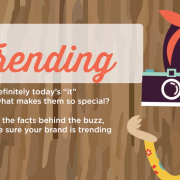Meet Millennials Where They Shop
Here’s a hint: it’s probably not the supermarket.
The millennials.
A segment so large and diverse, it seems almost silly to call it a segment at all. But as a group—in spite of their vast differences—millennials all share one very important thing: immense spending power.
And they’re not using it like their parents did.
One area where that’s increasingly apparent is in the grocery category. Last year, consumers between the ages of 25 to 34 spent an average of $3,539 on groceries—about $1,000 less than what the same age group spent in 19901.
Now, let’s be clear: that’s not to say millennials don’t dish out dollars on food. They do. In fact, certain research suggests they’re actually spending more on food, overall. But mainstream grocery just isn’t seeing that revenue.
So who is? One answer may surprise you.
The millennials—lovers of kale, craft beer and pricey lattes—have found an unlikely new home… in the land of beer caves, roller grills and 99-cent coffee.
Yes. C-stores.
Millennials currently represent one-third of all c-store traffic—despite making up only one-fourth of the total population2. Clearly, these proportions tell us that c-stores have something that’s drawing millennials—more so than other demographics.
So what is it, exactly?
When you sift through all the stats and trends, one key factor emerges. For millennials—leading busy, demanding lives—convenience matters.
Why stock up on staples, when you can shop for the moment?
Why spend time cooking, when you can grab something on the go?
Why drive out of your way, when it’s far easier to stop on your way?
These are questions that mainstream grocery chains have yet to reconcile. But for c-stores, it’s a golden opportunity. And many chains have already shifted their offerings to reflect millennial tastes: more fresh food, higher-quality products and even “destination dining” options.
It’s working.
Every year, c-stores capture more of the millennial market share. And by increasing their portfolio of “millennial friendly” products, c-store operators can expect to claim even more business from this vast demographic.
But c-store chains aren’t the only players that can score big in this new game…
Brands have a chance to reclaim ground they’ve lost in traditional retail by leveraging a more “captive” audience in c-stores: consumers who stop, buy what they want and don’t spend as much time comparison-shopping. Also, with less competition from private labels, the stage is set for brands to find a new level of success in this often overlooked channel.
And… the c-store renaissance has not gone unnoticed by certain savvy entrepreneurs…
As one example, Spot You More® Digital Promotions is using technology to help c-stores and brands make the most of the opportunity at hand. Spot You More is a universal (i.e., “chain-agnostic”) digital promotions platform that lets shoppers redeem personalized offers from their phones as they check out. No forgotten coupons. No store-specific apps. Just digital promotions exclusively designed for the c-store environment.
And since we all know the value millennials place on their phones, Spot You More is uniquely positioned to be exactly where this new generation of c-store aficionados is looking.
It’s no secret that change is the only constant in today’s ever-evolving retail reality. And as millennials continue to shift their attention away from supermarkets—to super convenience—we can expect the grocery channel to experience further fragmentation. All while the c-store channel grows, evolves and expands… into something… decidedly more millennial.
1Groceries and Millennials: They’re Buying Less, Shopping Online (consumerist.com)
2Six Keys to Connecting with Millennials (CSNews.com)
Other Sources:
Why Gas Stations May be the New Grocery Stores (www.chase.com)
Why do Millennials Hate Groceries? (www.theatlantic.com)
As a member of Seed’s copywriting team, Matt Donahue marries his love for creative writing with a keen interest in product innovation, technology and science. He’s a graduate of Seton Hill University’s “Popular Fiction” master’s program and writes whenever he can.
P.S. You can follow Seed Strategy on our LinkedIn, Twitter, Facebook and Instagram pages.







